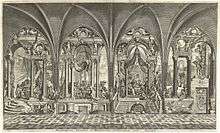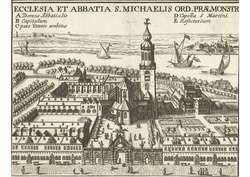St. Michael's Abbey, Antwerp
| Sint-Michielsabdij | |
|
St Michael's Abbey, Antwerp, engraved after Peter Paul Rubens | |
| Monastery information | |
|---|---|
| Other names | Abbatia Sancti Michaelis Antverpiae |
| Order | Premonstratensian |
| Established | 1124 |
| Disestablished | 1795 |
| People | |
| Founder(s) | Norbert of Xanten |
| Architecture | |
| Status | suppressed 1795 |
| Functional Status | demolished 1831 |
St Michael's Abbey in Antwerp was a Premonstratensian abbey founded in 1124 by Norbert of Xanten and laid waste during the French Revolutionary Wars. In 1807 a semaphore station was installed in the tower of the church.[1] The buildings were demolished in 1831.

The abbey has been described as "one of the key churches and most significant monuments in Antwerp from its foundation in the 12th century to its destruction in the nineteenth."[2]
History
Until 1124 a collegiate church dedicated to Saint Michael and served by 12 secular canons was the only parish church in Antwerp. In 1124 the chapter was reformed by St Norbert as a Premonstratensian abbey. The abbey buildings stood between what are now the streets Kloosterstraat and Sint-Michielskaai, and Sint-Jansvliet in the north and the Scheldestraat (Kronenbrugstraat) in the south.
The abbey obtained large tracts of land in and around Antwerp, such as the lordships of Kiel and Beerschot, the land of Haringrode and Zurenborg and as late as 1674 Berendrecht and Zandvliet, which helped shape the ultimate territory of Antwerp.
The abbey was partly destroyed by the French army during the War of the First Coalition in 1796. Many of the buildings were demolished to create military barracks and a naval arsenal with shipyards and slipways. In 1807 the tower of the abbey church was equipped with a semaphore. In 1831 the French barracks were bombarded by the Dutch garrison Commander David Hendrik Chassé, whose troops were holding the Citadel of Antwerp.
Art
Isabella of Bourbon (1436-1465), second wife of Charles the Bold, Duke of Burgundy, and the mother of Mary of Burgundy, heiress of Burgundy, died in the abbey in 1465 and was buried in the abbey church. In 1476 a monumental tomb was erected in her memory. It was decorated with 24 bronze statuettes of noble men and women standing in niches, known as 'weepers' or 'mourners', with a bronze effigy of Isabella herself surmounted on it. The remnants of the weepers are now kept in the Rijksmuseum (Amsterdam) and in M - Museum Leuven. The rest of the tomb, with the statue of Isabella, is now in Antwerp Cathedral. Nothing more of the tomb furnishings survives.
In the 17th century the monastery was well known as a patron of the arts, commissioning works from major Antwerp painters such as Peter Paul Rubens, Anthony van Dyck and Jacob Jordaens. Around 1624 Rubens delivered a monumental altarpiece for the abbey church, The Adoration of the Magi. It was stolen during the French occupation and after 1815 was returned to the Royal Museum of Fine Arts (Antwerp).
The floor with many tombstones was transferred to the Cathedral of Our Lady, that had lost its floor during the French occupation.
The 18th century communion bench and the confessional are now in the Church of St Gertrude in Bergen op Zoom (Netherlands).
Abbots
A list of abbots to 1709:[3]
- Waltmannus, 1124–1138
- Emelinus, died 1161
- Alardus, died 1162
- Thibaldus, resigned 1171
- Richardus, resigned 1188
- Waltherus de Stripe, died 1192
- Elias, died 1199
- Giselbertus, died 1205
- Hugo, died 1208
- Arnoldus de Erps, translated 1219
- Hermannus, died 1230
- Sigerius, died 1230
- Eggerius, died 1244
- Gerardus de Lira, died 1258
- Joannes de Lira, died 1272
- Aegidius de Biervliet, died 1286
- Henricus de Mechlinia, died 1300
- Godefridus de Waerloos, died 1328
- Guilielmus de Cabeliau, died 1341
- Guilielmus Lympiaes, died 1353
- Martinus Loys, died 1372
- Guilielmus Brulocht, died 1390
- Petrus Breem, died 1413
- Olardus Terlinck, died 1452
- Joannes Fierkens, died 1476
- Andreas Aechtenryt, died 1478
- Joannes Robyns, died 1486
- Joannes de Weerdt, died 1499
- Jacobus Elsacker, died 1505
- Jacobus Embrechts, died 1514
- Stephanus a Thenis, died 1518
- Cornelis de Mera, died 1538
- Gregorius de Dagis, died 1562
- Cornelius Emerici, died 1563
- Guilielmus de Greve, died 1581
- Emericus Andreae, died 1590
- Dionysius Feyten, died 1612
- Christianus Michaelius, died 1614
- Matthæus Yrsselius, died 1629
- Johannes Chrysostomus vander Sterre, died 1652
- Norbertus van Couwerven, died 1663
- Macarius Simeomo, STL, died 1676
- Hermannus vander Porten, died 1680
- Gerardus Knyff, died 1686
- Joannes Chrysostomus Teniers, died 1709
References
- ↑ Rob Korving, Bart van der Herten, Een tijding met de snelheid des bliksems: de optische telegraaf in de Nederlanden (1800-1850) (Leuven University Press, 1997), p. 63.
- ↑ B. Haeger, "Abbot Van der Steen and St Michael's Abbey: The restoration of its church, its images, and its place in Antwerp", in Sponsors of the Past: Flemish Art and Patronage, 1550-1700, edited by Hans Vlieghe and K. Van Der Stighelen (Brepols: Turnhout, 2005), p. 157.
- ↑ From Jean François Foppens, Historia episcopatus Antverpiensis (Joannes Franciscus Broncart, Liège, 1717), pages 147-150.
External links
- A seventeenth-century view of St Michael's Abbey, available on Google Books.
Coordinates: 51°12′54″N 4°23′36″E / 51.2150°N 4.3932°E
